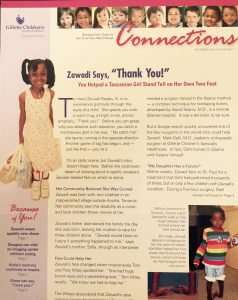Back in 2009 at Gillette Children’s Hospital Foundation we had a problem. Our newsletter, Momentum, was an institution unto itself. It won multiple communications awards. The staff raved about it. The CEO loved her nearly full-page column.
It was packed full of insider information. Articles about new technology being used at the hospital. Informative columns about new doctors. Frequent stories about how great the hospital was and all the things the hospital and its staff had accomplished.
But…every time we put that newsletter in the mail, we lost money. To the tune of $40,000 in lost revenue annually.
I knew we needed to make drastic changes to the newsletter if we wanted any chance at increasing revenue. As you can imagine, this was no easy task. Talk about killing the sacred cow. It took more than a year of serious negotiation, along with great partnership from one of the best creative writers I’ve ever met just to get the Marketing team to let us test a new approach.
Here’s what we changed:
We made the donor the absolute hero
We replaced all of the institutionally-focused articles and content with stories about the amazing life-saving and life-changing work that our donors made possible at the hospital.
In a publication that rarely ever before spoke directly to donors, we aggressively used the word “You”. And we didn’t just bury it in body copy. We put it right in the headlines, in pull quotes, and all throughout the articles. We wanted donors to clearly understand that they, not we, were the reason that kids’ lives were being changed at the hospital.
We took every possible opportunity to thank our donors. Our CEO thanked them in her column. Physicians thanked them in articles. Parents, grandparents and patients thanked them throughout the stories in each newsletter.
We focused on emotionally compelling stories, not scholarly articles
This was one of the most challenging changes for the hospital administration to swallow. Where once you would have found articles touting the multiple benefits and features of advanced imaging technologies or planned infrastructure improvements at the hospital, we instead began telling human interest stories.
We told stories of a little girl from Tanzania who came to the U.S. unable to walk because she had two club feet. Because of the generous support of our donors, who helped get her to the U.S., and find the only hospital in the nation with a doctor skilled enough to fix her complex condition, she’s now able to run and play.
We told the story of a father whose daughter was critically injured in a car accident. Doctors had told him to say his goodbyes and prepare for the worst. But because of the generosity of our donors, the hospital was equipped with the best technology and the most talented medical staff. Not only did his daughter live, but she made a near full recovery – and her dad got to see her graduate from high school!
These are the kind of stories that made Connections different.
We changed the look and feel
Momentum used to be an 18-page, glossy, two-color, self-mailer that was copy intensive, and only sparingly used photos.
The first thing we changed was the name and branding.
It became Connections: Bringing You Closer to the Lives You Help Change.
Without increasing costs at all, we drastically changed the format. We cut article lengths significantly. We increased the use of photos – great photos – of the kids we served, and of their families. We moved to four-color, and reduced the page count to four. We created a cover letter and reply device that were personalized to the donor (and included personalized ask arrays). And we put it in an envelope with a great teaser letting donors know it was a newsletter specifically for them.
What was the outcome?
The first time we put the updated newsletter in the mail, [bctt tweet=”it raised over $50,000. That’s 1,000% more revenue than the Momentum newsletter had ever raised in a single issue.”]
Donors raved about the changes as well. We got calls, emails, and handwritten notes telling us how much donors appreciated new fresh look and feel, and the wonderful stories. We even had several major donors who had been distant for several years respond to the newsletter. One of those responses came alongside a $10,000 check!
We got a lot of industry exposure as well.
The Direct Marketing Association’s Nonprofit Foundation featured our changes in The Journal, the DMANF’s quarterly publication. Tom Ahern (whose newsletter writing insights shaped our strategy) picked the story up and has included it in one of his books since. And Connections also won a Gold Quill for Excellence from the International Association of Business Communicators.
What do you need to change in your organization’s newsletter in order for it to raise more money?

[…] Andrew Olsen, from Andrew Olsen’s Fundraising Fundamentals, gives us another example in We Increased Our Newsletter Revenue by 1000%. Here’s How… […]